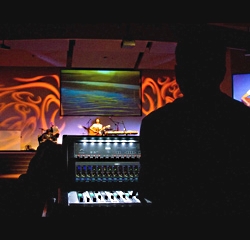Being the online forum lurker that I sometimes am, there are times when I’m struck by a pattern or trend that was never clear before (for whatever reason). It happened just a while ago, and the context is relevant to what we do in our business of live sound.
This particular discussion, on a music forum, was a thread about “the great tone we’ve spent years perfecting that is destroyed when it goes through a PA.” (You guessed it – I’m talking about guitar players here.) These guys and gals do indeed often spend an inordinate amount of time fiddling with strings, pickups, pedals, guitar cables, tubes and the like, all in an effort to realize the holy grail: the perfect guitar tone for a particular song or passage.
In a way, this quest can never be fully satisfying, because there really is no “perfect” tone. However, the sonic signature coming from a guitar rig is very personal and can indeed make a big difference in a song. Some players are known for their particular tone, with one of the most famous being the “brown sound” of Eddie Van Halen, epitomized on the band’s first album.
But what do these folks mean when they say their tone is lost in the PA? Further, the thread included a second group pointing out that this doesn’t have to be the case. Several of them explained that with a proper PA, the right microphone and a decent bloke behind the desk, the player’s tone should be amplified just as he or she desired it to be.
Worlds Apart?
It got me to thinking about how difficult communication can be between different types of people on and around the stage. The four types that I can ID in this scenario include the artist (musician), his/her tech, the monitor engineer, and the front of house engineer. In my view, this chain contains the most important parts of the equation. Perhaps the system tech can have an influence as well, but generally will plan for a flat PA and correct gain structure, with perhaps a touch of “flavor” per the FOH engineer’s taste.
What I’ve observed over the years is that in many ways, these four parties don’t necessarily communicate as well as possible. Sure, artists and monitor engineers are most likely talking and getting things sorted out. Instrumentalists and their techs are probably communicating effectively. But are the techs and FOH, and maybe even FOH and monitors communicating? For that matter, how about the artists and FOH?
This is likely the heart of the issue, for several reasons. FOH engineers and the artists they work with often have different purposes. The audience is focused on the artist, while the house system exists to deliver what they expect to hear. This may seem like a contradiction, but really, performing and mixing are two different worlds. Which brings me back to the thing about guitarists and the PA.
Of IEMs & Men
What the artist wants and/or needs to hear in their in-ear monitors and/or wedges is not at all the same as what comes out of the house system. And therein lies one of the fundamental issues. In many cases, the artist doesn’t know what his/her tone sounds like from the audience perspective. By the same token, the FOH engineer doesn’t necessarily know what the mix sounds like in the artist’s ears.
Thus artists and monitor engineers share their own world, while FOH is on another planet. Of course, this is largely the way things should be. But what if the FOH engineer could tap into various monitor mixes to get an idea of what the artists are hearing? What if monitors could listen in on the main house mix? Would this be of value? It probably depends on the artists and engineers involved.
Certainly today, with the proliferation of digital transport (think Dante or AVB), this is no longer an impossible task. Depending on the system, it’s probably not cumbersome or cost prohibitive either. Anyway, it’s something to consider
Stageside Manner
Another aspect is some animosity (and dare I say, at times, outright disrespect) between the various parties. Some on the engineering side seem to think that musicians are, well, idiots, and many musicians believe that engineering types don’t have the first clue about music.
It’s because the two specialties are often at cross purposes. Some musicians are not technically oriented, and certainly their goals and perspectives can be different from engineers who are dealing with a wide range of challenges and often don’t share the same concerns as musicians. Again, none of this is necessarily wrong.
But if our goal is to connect the artists to the audience and vice versa, perhaps we can be a bit more empathetic. Doctors call it “bedside manner,” but it applies to our field too. For instance, if a guitarist suggests that “all I need is a ‘57 placed on the upper left speaker,” sometimes an engineer’s inclination is to say “well, I can make it work better with a 421.” But in reality, if we can’t get a decent guitar tone with a ‘57, we shouldn’t be in this business.
Perhaps a better way to handle it would be to accept what the musician says and just make it happen to the best of our ability. Or, one step further: get things set up and then offer the musician the chance to listen from the house and determine if this is the sound he/she is after. People are often more comfortable if some of their ideas are incorporated into the solution.
By the same token, it would be nice for musicians to trust engineers more to preserve the core of their sound and represent them properly. A “stageside manner” will help, but so will competence and confidence as long as it doesn’t turn into arrogance. Something to keep in mind with any musician listening to the mix is the “3 dB rule,” which in essence states that most musicians will want to hear themselves about 3 dB louder than is appropriate. Thus it’s smart to leave some room to boost the sound, which can then be readjusted accordingly come showtime.
As for the audience, shows are usually an overall “experience” that they want to enjoy. They may not know if there are problems, or the really fine points of an amazing mix. They probably won’t say “I heard a great show last night” but they will say “I went to a great show last night.” And their experience will be enhanced by quality sound reinforcement, especially if they can hear the lyrics clearly and feel the groove.
As has often been said: “No one ever leaves a show humming the lights.” But they probably don’t leave humming the kick drum or the bass line in most cases, either. The priority is still the artist, the song, and the audience. If we can learn to communicate better, we’ll be in good stead with this holy trinity.















